Dissolution-Repackaging of Hellandite-(Ce), Mottanaite-(Ce)/Ferri-Mottanaite-(Ce)
Abstract
1. Introduction
2. Geological Setting
3. Methods
4. Results
4.1. Hellandite-Group Mineral Phases
4.2. Other Associated Mineral Phases
5. Discussion
5.1. Mineral Chemistry
5.2. Crystal Chemical Structure
5.3. Genetic Conditions
6. Conclusions
- On four composite crystals of hellandite-group minerals, we observed a chemical transition from hellandite sensu strictu to mottanaite to ferri-mottanaite.
- Hellandite-(Ce) shows immiscibility features both with mottanaite (chessboard like domains) and ferri-mottanaite (perthite-like vermiculation). Data analysis and molar endmember calculations testify complex behaviour to form a molar mixture with an immiscibility gap.
- According to point 2, in our composite crystals, the presence of different compositional domains and immiscible features may be due to disequilibrium upon sub-solidus conditions and quench, respectively. These textures can be interpreted in terms of growth stories and diffusion-reaction processes or dissolution-repackaging.
- Crystal n.1 of hellandite sensu strictu shows a peculiar high ss at the T site (epfu) and the shortest <T-O> bond concerning literature data. Be-Li content is not sufficient to explain this structural feature. We guess that T-site distortion is inherited by a hellandite precursor mineral such as gadolinite-(Ce). This would be confirmed by high HREE content (Figure 6).
- Crystallisation sequence and changes in composition, especially concerning LREE/HREE ratio and Eu anomaly, suggest that the observed variations are linked to drop in temperature and increase in the availability of oxygen during the late hydrothermal stage.
- Ferri-mottanaite concentric zoning is due to variation in Ca, Th, Ce content, probably related to late-stage crystallisation of other REE-silicates such as pyrochlore and other titanates.
- We suggest that the hellandite + brockite assemblage precipitated from highly fractionated, F-rich carbothermal fluids temporally related to carbonatite emplacement. Low-temperature hydrothermal conditions are supported by the presence of fine-grained fluorite and zeolites and hydration of REE-phosphate and vanadate minerals [11]. Fluid interaction with syenite may initiate fluorite crystallisation, which may cause destabilisation of (HREE, Ti, Nb)-complexes and precipitation of LREE + Th-silicate and phosphates and, finally, pyrochlore, a model valuable to the exploration for economic concentrations of REEs, Ti and Nb.
Author Contributions
Funding
Data Availability Statement
Acknowledgments
Conflicts of Interest
References
- Mellini, M.; Merlino, S. Hellandite; A new type of silicoborate chain. Am. Mineral. 1997, 62, 89–99. [Google Scholar]
- Oberti, R.; Ottolini, L.; Camara, F.; Della Ventura, G. Crystal structure of non-metamict Th-rich hellandite-(Ce) from Latium (Italy) and crystal chemistry of the hellandite-group minerals. Am. Mineral. 1999, 84, 913–921. [Google Scholar] [CrossRef]
- Della Ventura, G.; Bonazzi, P.; Oberti, R.; Ottolini, L. Ciprianiite and mottanaite-(Ce), two new minerals of the hellandite group from Latium (Italy). Am. Mineral. 2002, 87, 739–744. [Google Scholar] [CrossRef]
- Oberti, R.; Della Ventura, G.; Ottolini, L.; Hawthorne, F.C.; Bonazzi, P. Re-definition, nomenclature and crystal-chemistry of the hellandite group. Am. Mineral. 2002, 87, 745–752. [Google Scholar] [CrossRef]
- Miyawaki, R.; Momma, K.; Yokoyama, K.; Shigeoka, M.; Matsubara, S.; Ito, M.; Nakai, I.; Kristiansen, R. Mn-bearing Hellandite-(Y) from the Heftetjern pegmatite, Tørdal, Norway. Can. Mineral. 2015, 53, 345–346. [Google Scholar] [CrossRef]
- Oberti, R.; Langone, A.; Boiocchi, M.; Bernabè, E.; Hawthorne, F.C. News from the hellandite group: The redefinition of mottanaite and ciprianiite and the new mineral description of ferri-mottanaite-(Ce), the first Fe3+-dominant hellandite. Eur. J. Mineral. 2019, 31, 799–806. [Google Scholar] [CrossRef]
- Washington, H.S. The Roman Comagmatic Region; Carnegie Institution for Science: Washington, DC, USA, 1906; Volume 57, p. 199. [Google Scholar]
- Stoppa, F.; Cundari, A.; Rosatelli, G.; Woolley, A.R. Leucite melilitolites in Italy: Genetic aspects and relationships with associated alkaline rocks and carbonatites. Per. Mineral. 2003, 72, 223–251. [Google Scholar]
- Goodenough, K.M.; Schilling, J.; Jonsson, E.; Kalvig, P.; Charles, N.; Tuduri, J.; Deady, E.A.; Sadeghi, M.; Schiellerup, V.; Muller, A.; et al. Europe’s rare earth element resource potential: An overview of REE metallogenetic provinces and theirgeodynamic setting. Ore Geol. Rev. 2016, 72, 838–856. [Google Scholar] [CrossRef]
- Stoppa, F.; Pirajno, F.; Schiazza, M.; Vladykin, N.V. State of the art: Italian carbonatites and their potential for critical-metal deposits. Gondwana Res. 2016, 37, 152–171. [Google Scholar] [CrossRef]
- Stoppa, F.; Schiazza, M.; Rosatelli, G.; Castorina, F.; Sharygin, V.V.; Ambrosio, F.A.; Vicentini, N. Italian carbonatite system: From mantle to ore-deposit. Ore Geol. Rev. 2019, 114, 103041. [Google Scholar] [CrossRef]
- Momma, K.; Izumi, F. VESTA 3 for three-dimensional visualization of crystal, volumetric and morphology data. J. Appl. Crystallogr. 2011, 44, 1272–1276. [Google Scholar] [CrossRef]
- Lafuente, B.; Downs, R.T.; Yang, H.; Stone, N. The power of databases: The RRUFF project. In Highlights in Mineralogical Crystallography; Ambruster, T., Danisi, R.M., Eds.; W. De Gruyter: Berlin, Germany, 2015; pp. 1–30. [Google Scholar] [CrossRef]
- Rossi, P.; Bellatreccia, F.; Caprilli, E.; Parodi, G.C.; della Ventura, G.; Mottana, A. A new occurrence of rare minerals in an ejectum in the pyroclastics of Vico Volcano, Roman Comagmatic Region, Italy. Rend. Lincei 1995, 9, 147–156. [Google Scholar] [CrossRef]
- Hawthorne, F.C.; Huminicki, D.M.C. The crystal chemistry of beryllium. In Beryllium: Mineralogy, Petrology and Geochemistry; Reviews in Mineralogy and Geochemistry; Grew, E.S., Ed.; Mineralogical Society of America: Chantilly, VA, USA, 2002; Volume 50, pp. 333–403. [Google Scholar]
- Shannon, R.D. Revised effective ionic radii and systematic studies of interatomic distances in halides and chalcogenides. Acta Cryst. 1976, A32, 751–767. [Google Scholar] [CrossRef]
- Hogarth, D.D.; Chao, G.Y.; Harris, D.C. New data on hellandite. Can. Mineral. 1972, 11, 760–776. [Google Scholar]
- Della Ventura, G.; Williams, C.T.; Cabella, R.; Oberti, R.; Caprilli, E.; Bellatreccia, F. Britholite-hellandite intergrowths and associated REE-minerals from the alkali-syenitic ejecta of the Vico volcanic complex (Latium, Italy); petrological implications bearing on REE mobility in volcanic systems. Eur. J. Mineral. 1999, 11, 834–854. [Google Scholar] [CrossRef]
- Wood, S.A. The Aqueous Geochemistry of Zirconium, Hafnium, Niobium and Tantalum. In Rare-Element Geochemistry and Mineral Deposits; Linnen, R., Samson, I., Eds.; Geological Association of Canada Short Course Notes: London, UK, 2005; Volume 17, pp. 217–251. [Google Scholar]
- Timofeev, A.; Migdisov, A.A.; Williams-Jones, A.E. An experimental study of the solubility and speciation of niobium in fluoride-bearing aqueous solutions at elevated temperature. Geochim. Cosmochim. Acta 2015, 158, 103–111. [Google Scholar] [CrossRef]
- Guo, D.X.; Liu, Y. Occurrence and geochemistry of bastnasite in carbonatite-related REE deposits, Mianning-Dechang REE belt, Sichuan Province, SW China. Ore Geol. Rev. 2019, 107, 266–282. [Google Scholar] [CrossRef]
- Su, J.H.; Zhao, X.F.; Li, X.C.; Hu, W.; Chen, M.; Xiong, Y.L. Geological and geochemical characteristics of the Miaoya syenite-carbonatite complex, Central China: Implications for the origin of the REE-Nb-enriched carbonatite. Ore Geol. Rev. 2019, 113, 103101. [Google Scholar] [CrossRef]
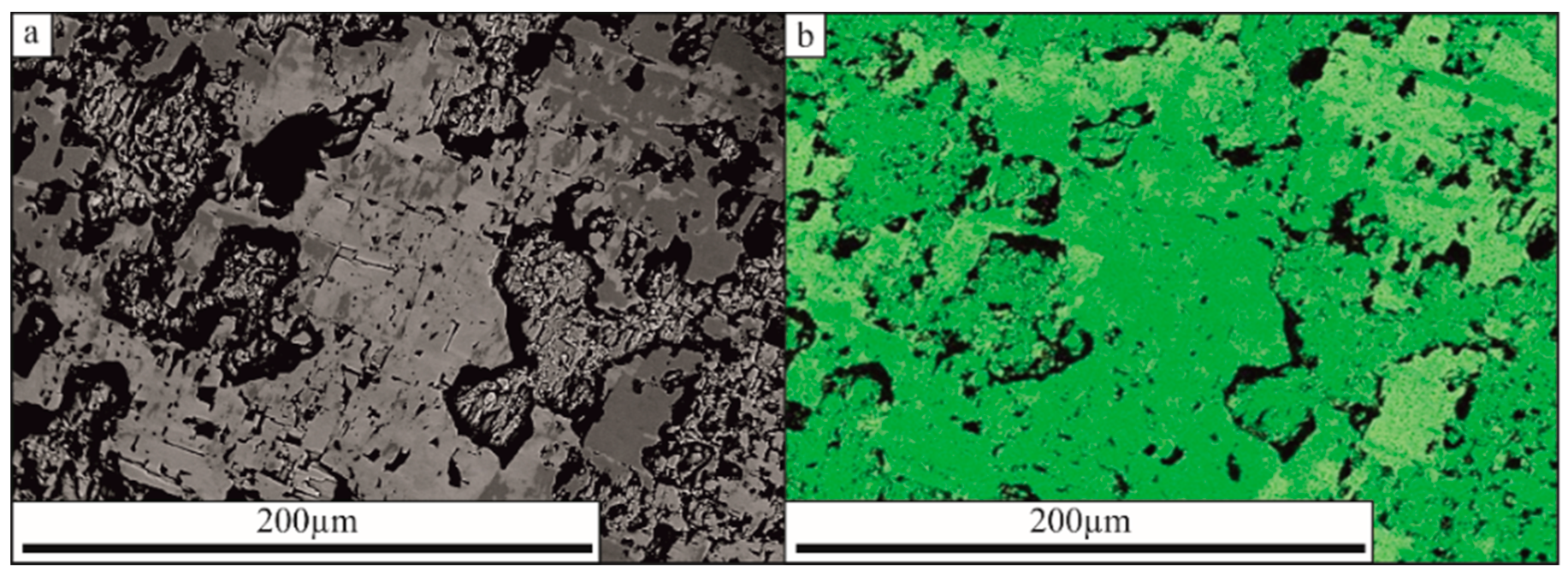
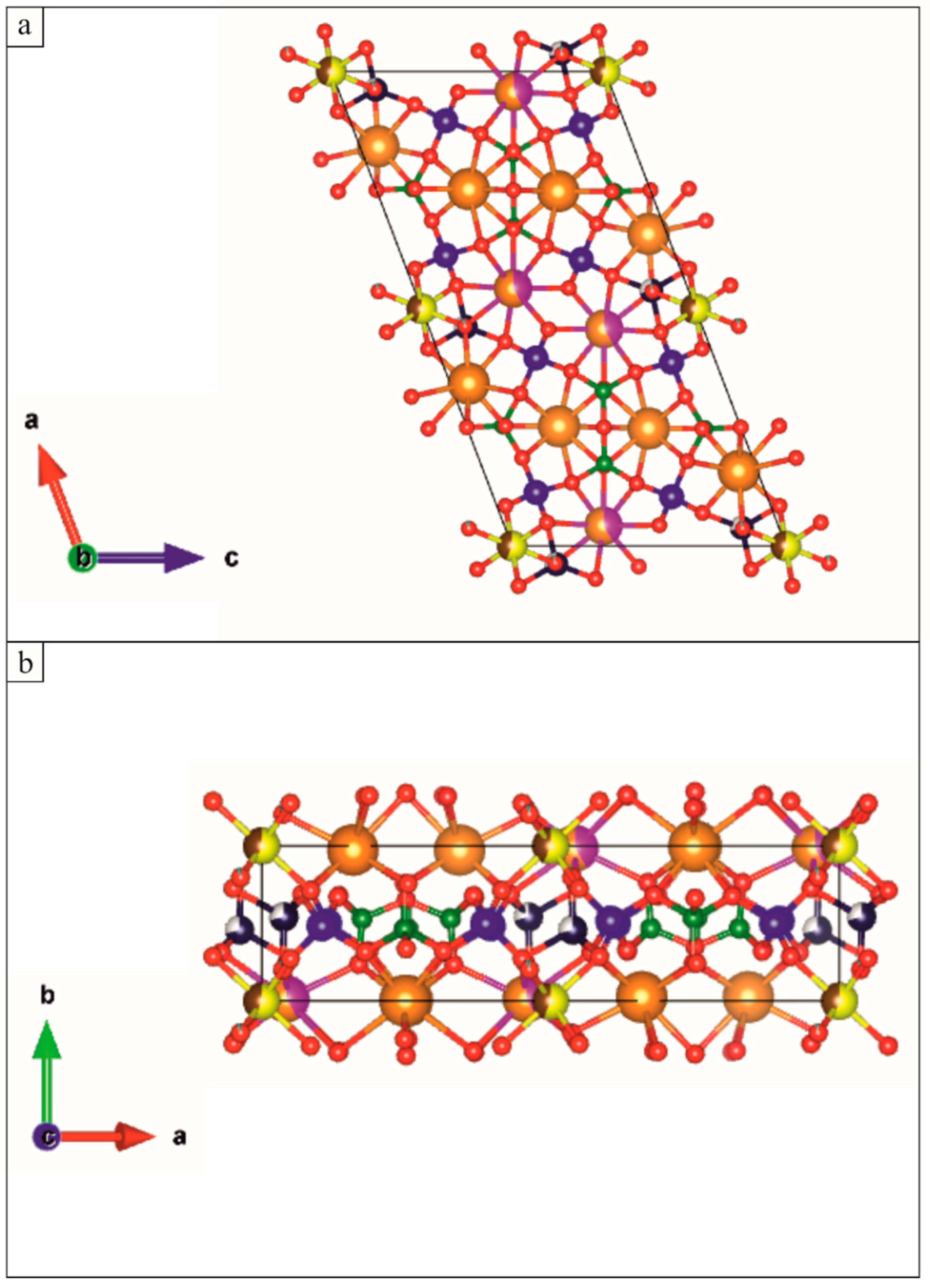
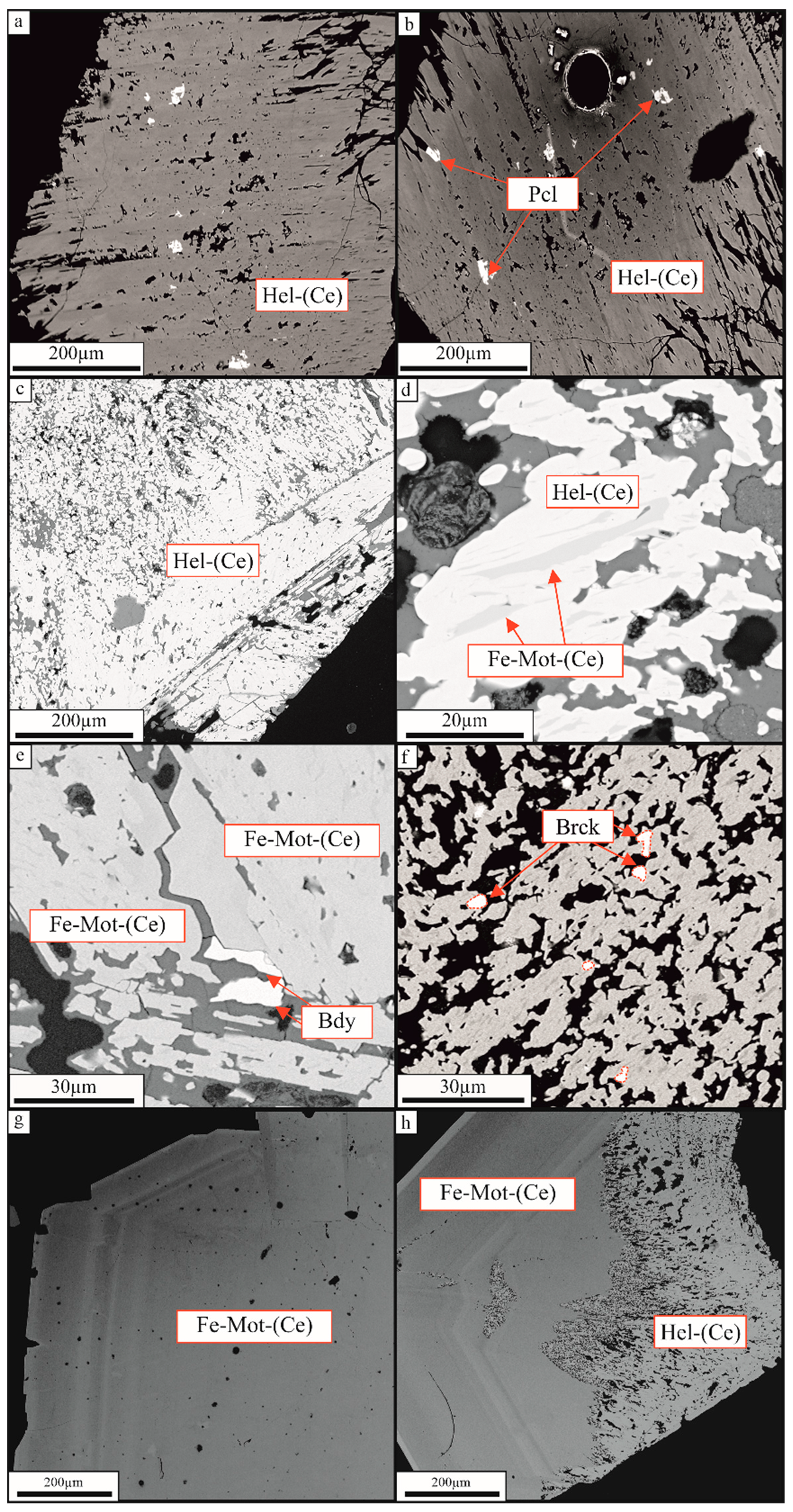
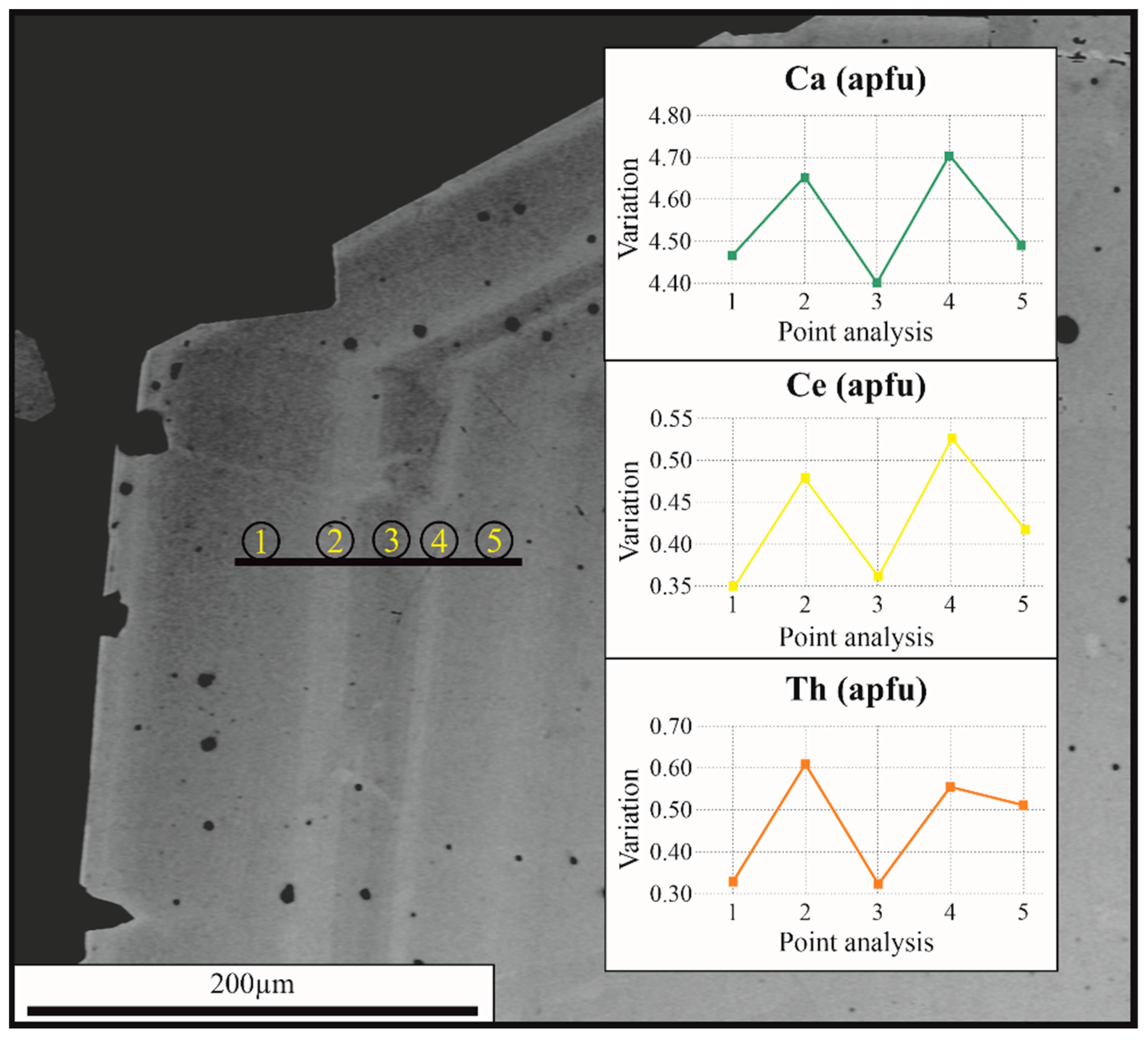
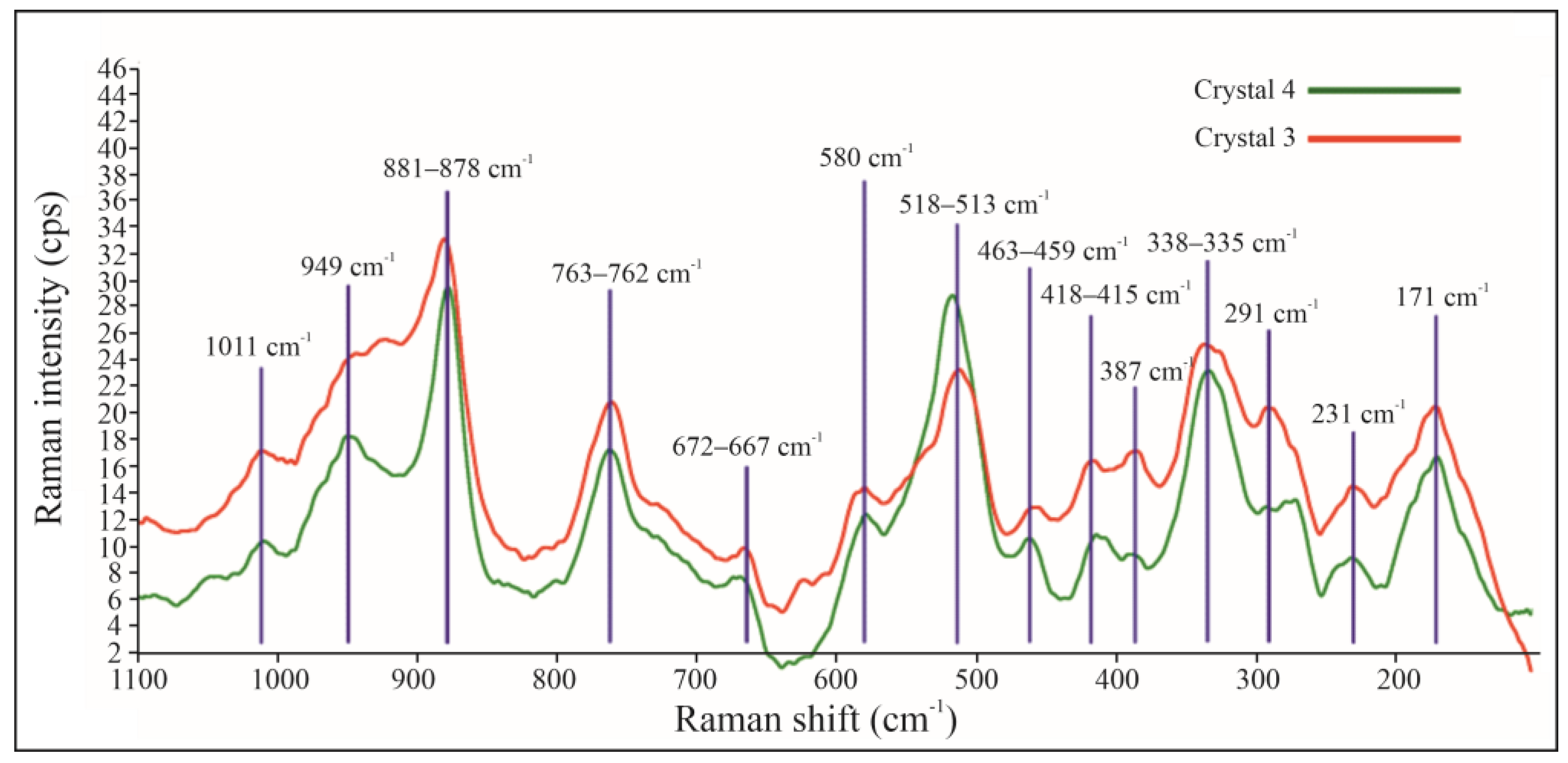
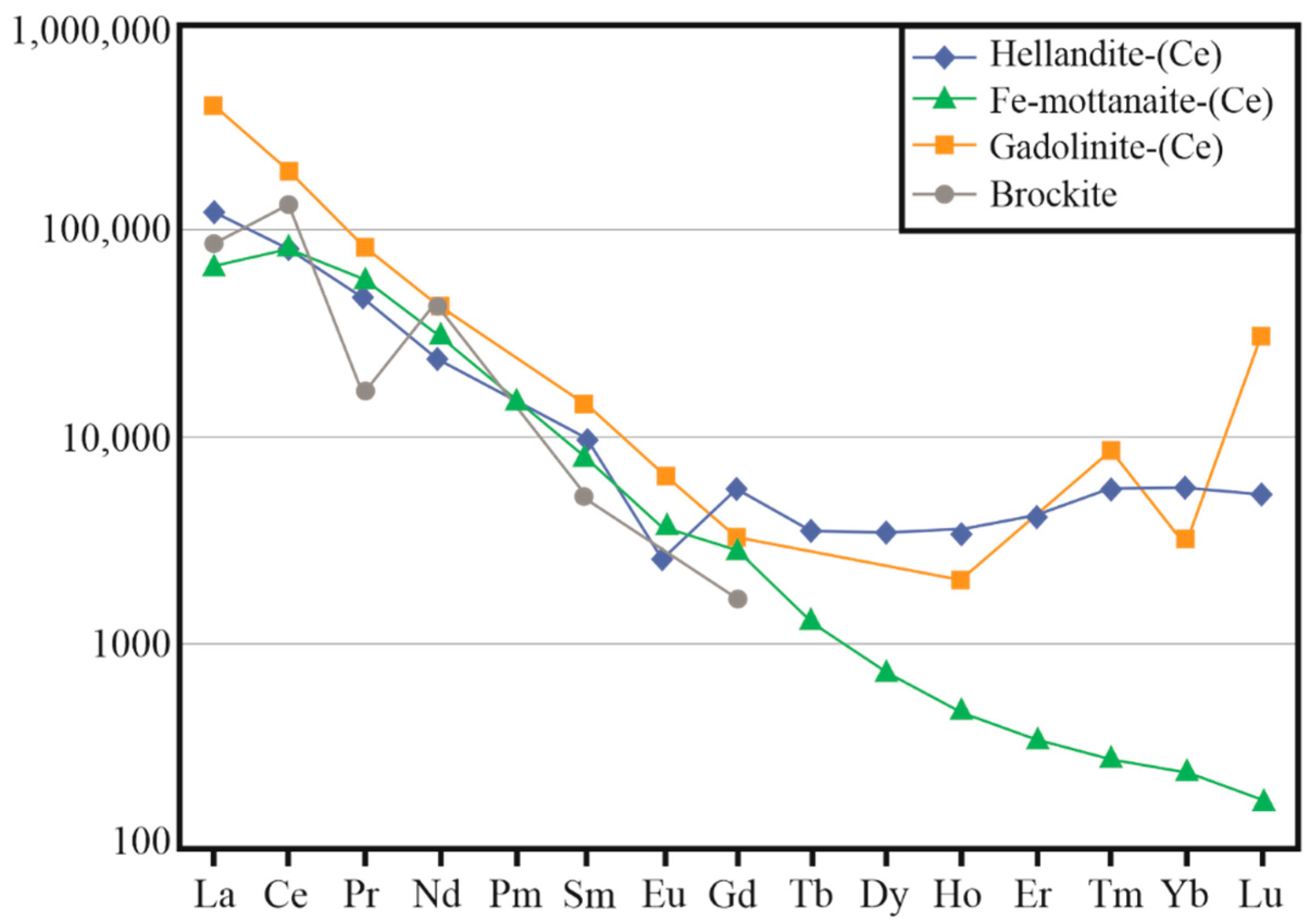
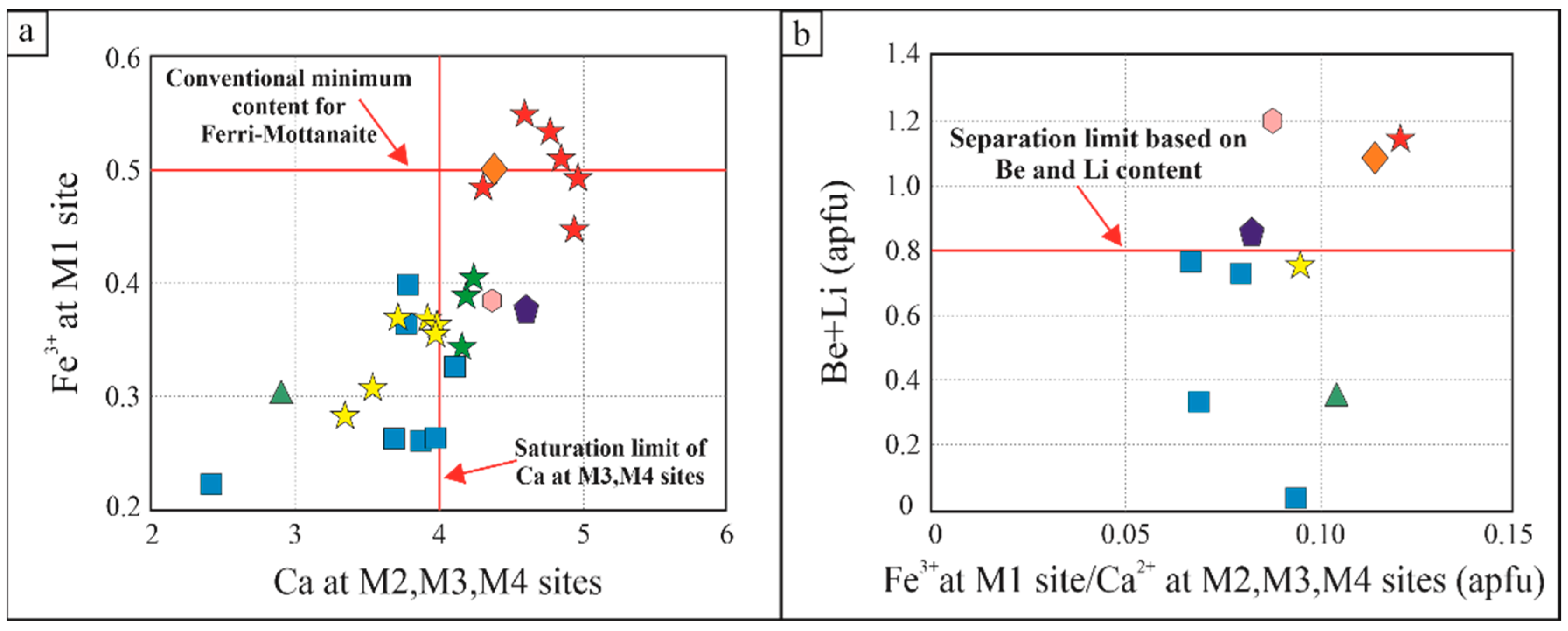
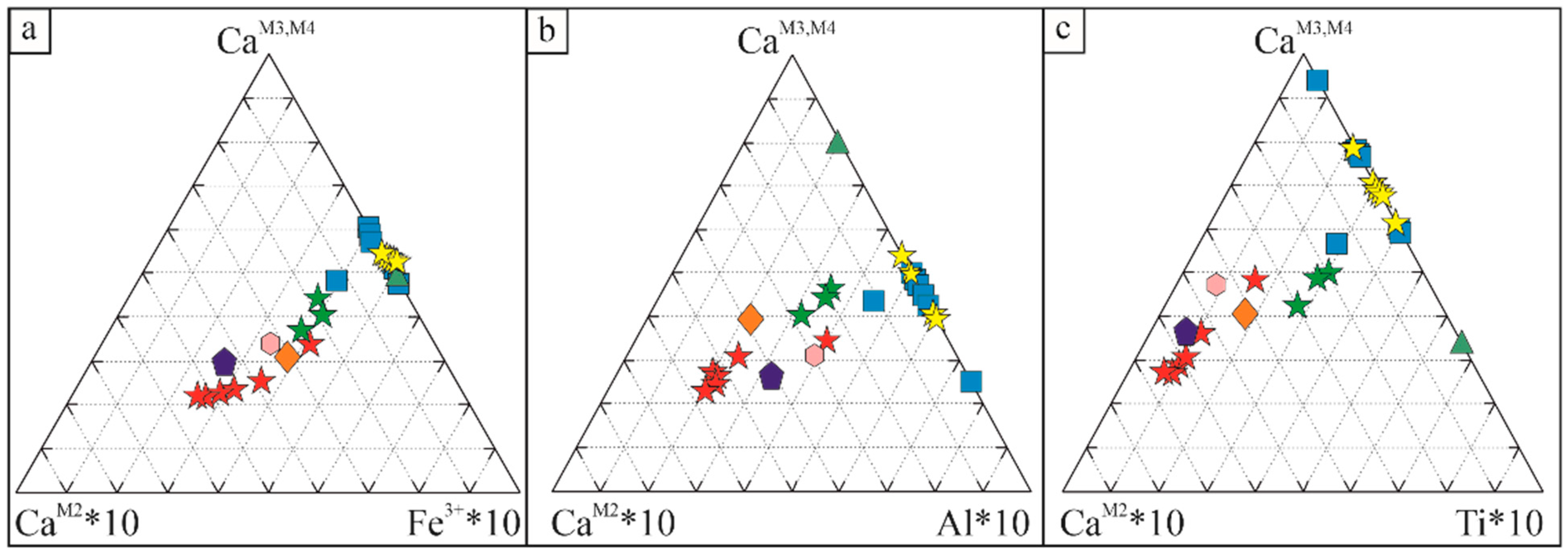
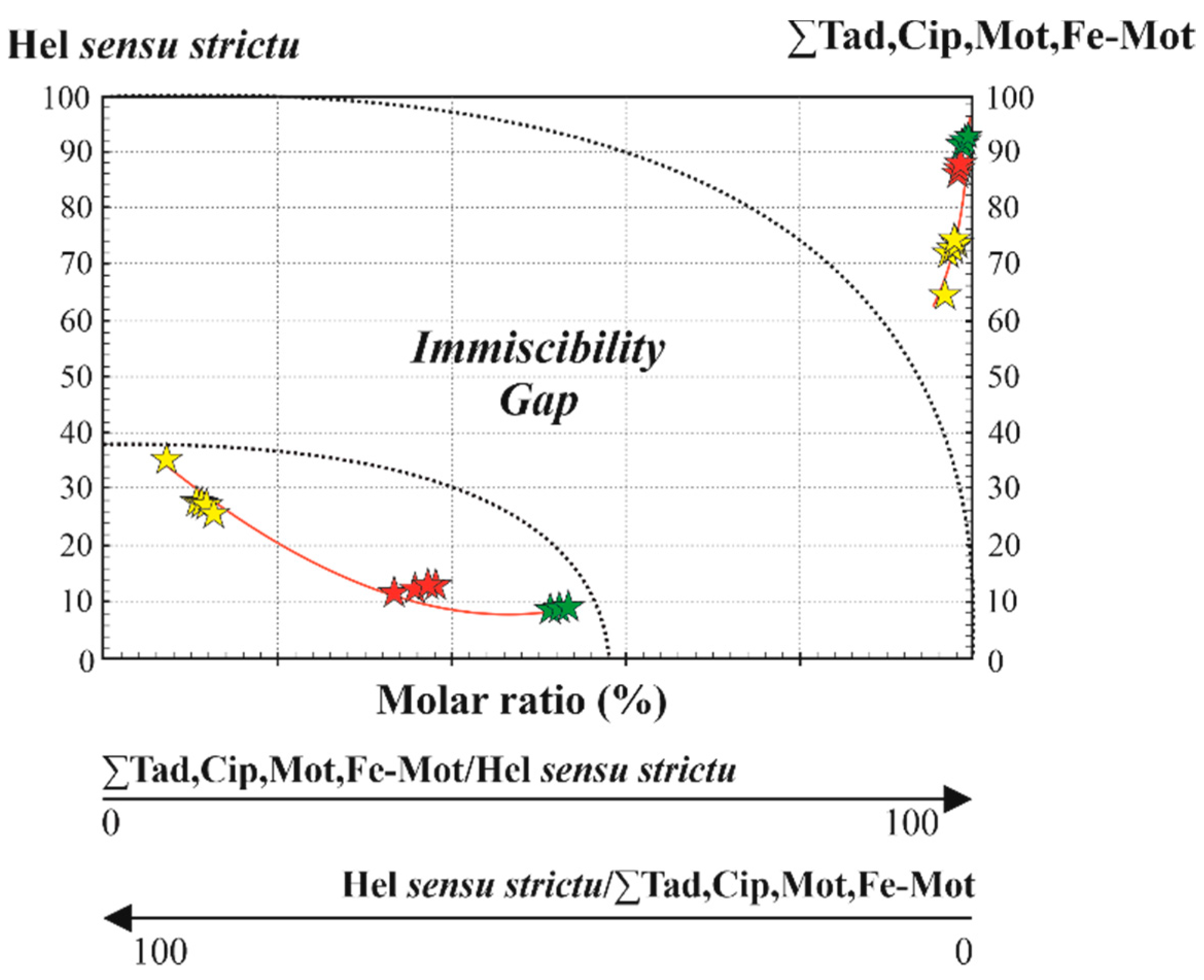

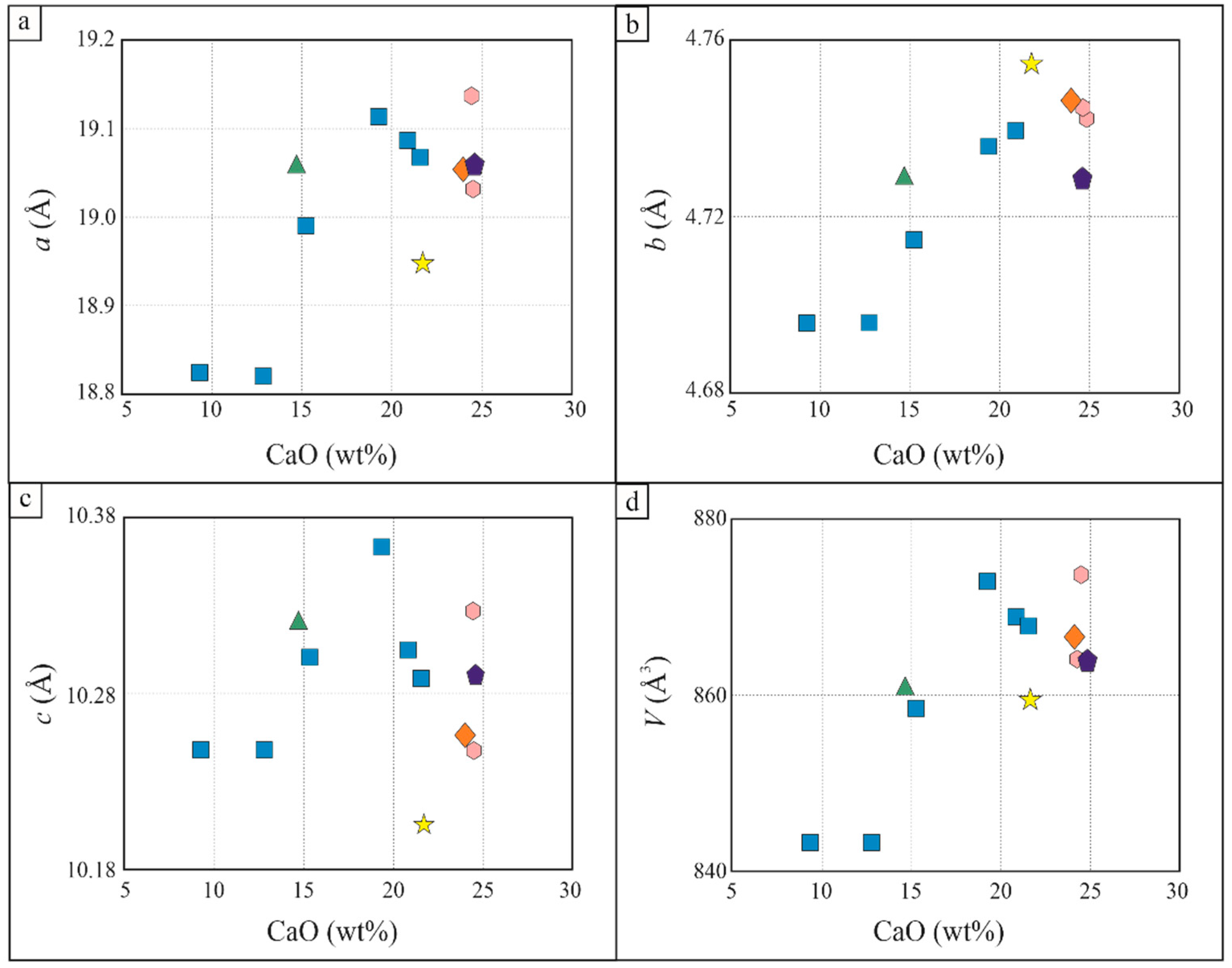
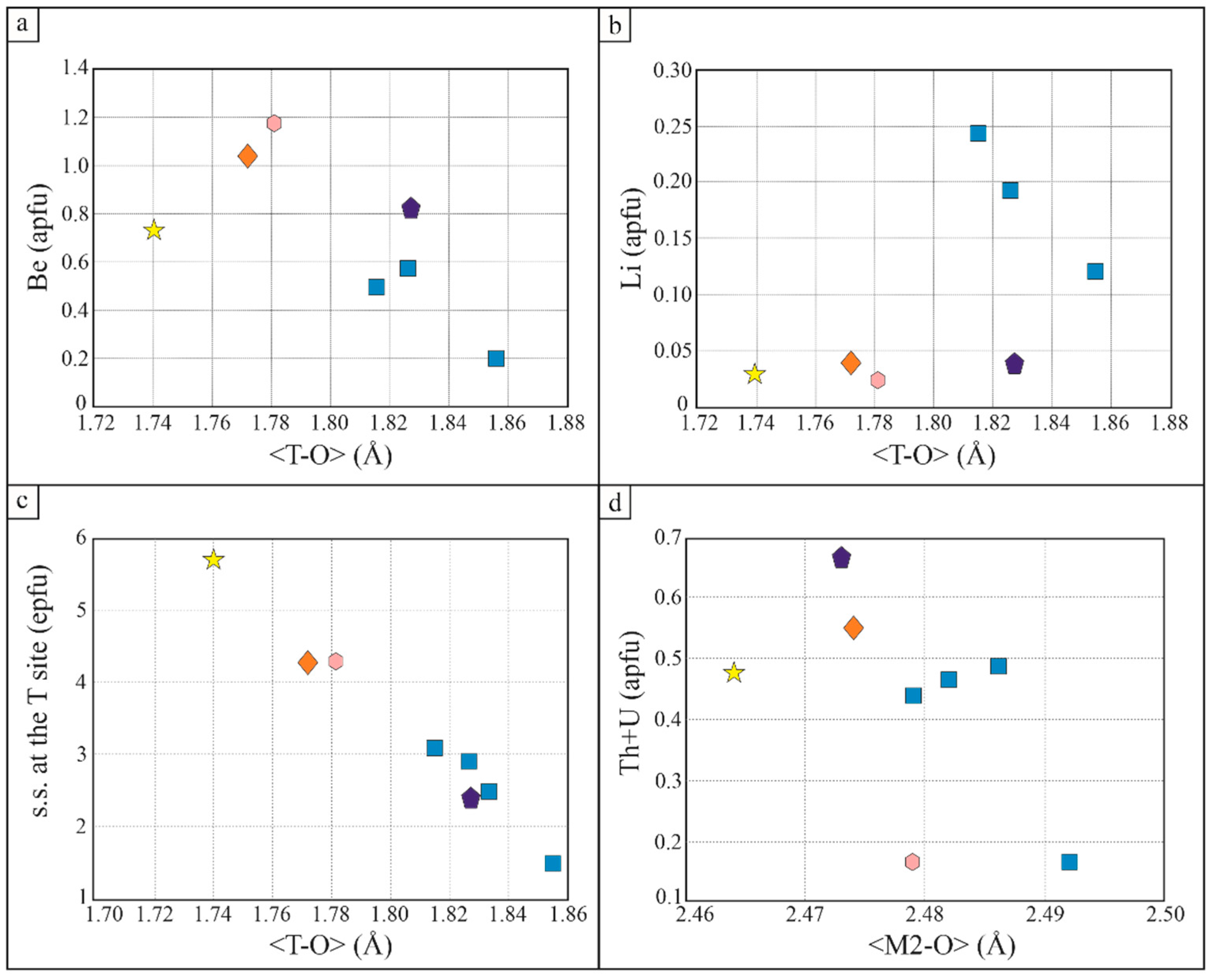
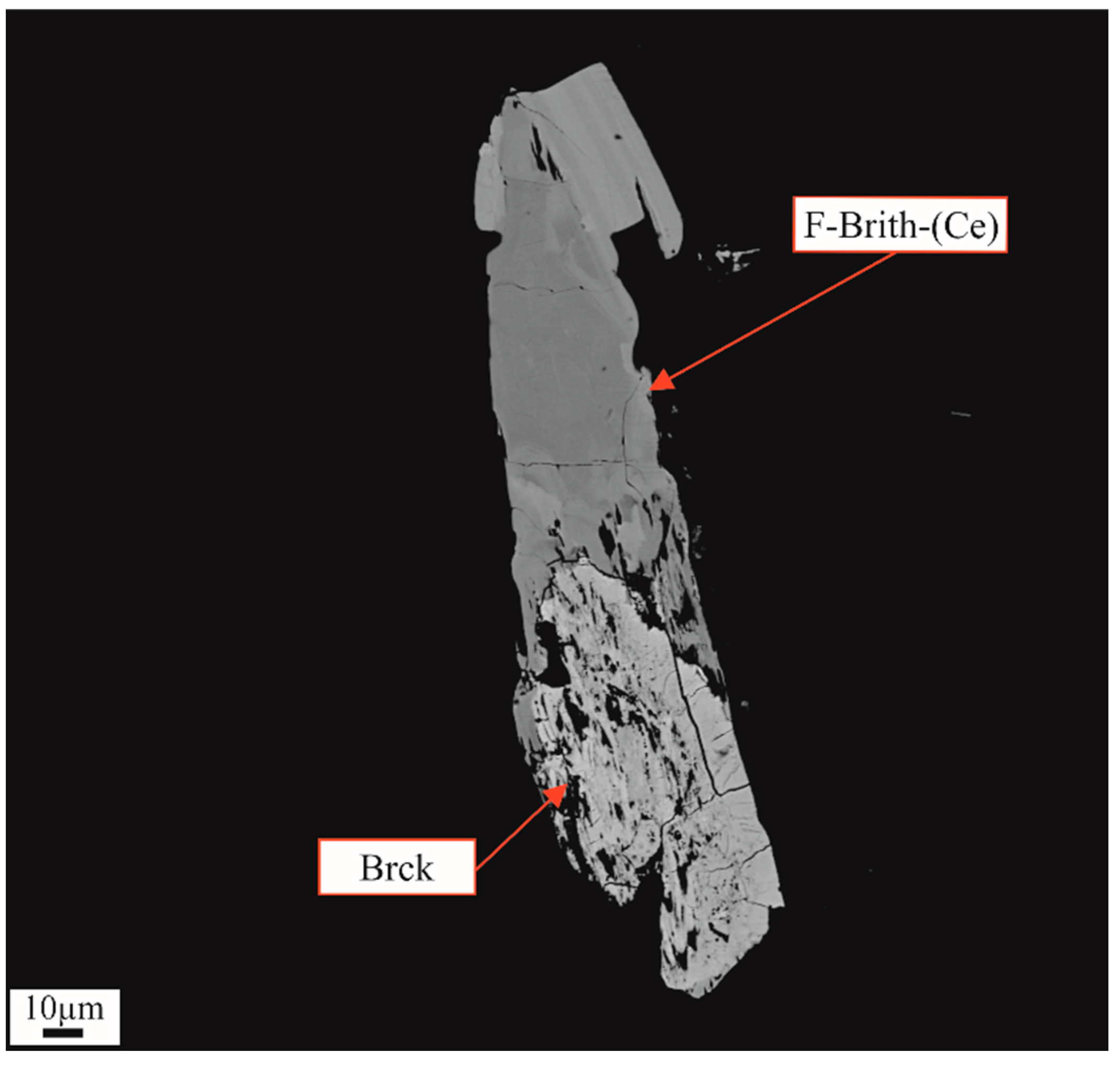
| Sample | HEL 1 | Apfu on 22 Ox | Sample | MOT 1 | Apfu on 22 Ox | ||
|---|---|---|---|---|---|---|---|
| SiO2 | 22.6 | Si | 3.793 | SiO2 | 23.4 | Si | 4.086 |
| Al2O3 | 1.65 | B | 4.323 | Al2O3 | 1.47 | B | 3.913 |
| CaO | 21.7 | Be | 0.727 | CaO | 22.4 | Be | n.d. |
| MgO | 0.21 | Li | 0.029 | MgO | 0.26 | Li | n.d. |
| Fe2O3 | 2.90 | ∑T | 8.872 | Fe2O3 | 2.71 | ∑T | 8.000 |
| Mn2O3 | 0.82 | Ti | 0.162 | Mn2O3 | 0.62 | Ti | 0.238 |
| TiO2 | 1.28 | Al | 0.327 | TiO2 | 1.82 | Al | 0.302 |
| Y2O3 | 1.13 | Fe | 0.367 | Y2O3 | 0.56 | Fe | 0.394 |
| La2O3 | 4.54 | Mn | 0.078 | La2O3 | 7.64 | Mn | 0.092 |
| Ce2O3 | 7.80 | Mg | 0.051 | Ce2O3 | 10.1 | Mg | 0.068 |
| Pr2O3 | 0.64 | ∑M1 | 0.985 | Pr2O3 | 0.63 | ∑M1 | 1.096 |
| Nd2O3 | 1.69 | Na | 0.000 | Nd2O3 | 1.32 | Na | 0.000 |
| Sm2O3 | 0.22 | Ca | 3.913 | Sm2O3 | 0.12 | Ca | 4.189 |
| Eu2O3 | 0.02 | La | 0.282 | Eu2O3 | n.d. | La | 0.491 |
| Gd2O3 | 0.17 | Ce | 0.480 | Gd2O3 | 0.10 | Ce | 0.644 |
| Tb2O3 | 0.02 | Y | 0.089 | Tb2O3 | n.d. | Y | 0.046 |
| Dy2O3 | 0.13 | Pr | 0.032 | Dy2O3 | n.d. | Pr | 0.040 |
| Ho2O3 | 0.03 | Nd | 0.083 | Ho2O3 | n.d. | Nd | 0.082 |
| Er2O3 | 0.10 | Sm | 0.011 | Er2O3 | n.d. | Sm | 0.007 |
| Tm2O3 | 0.02 | Eu | 0.001 | Tm2O3 | n.d. | Eu | n.d. |
| Yb2O3 | 0.14 | Gd | 0.008 | Yb2O3 | n.d. | Gd | 0.055 |
| Lu2O3 | 0.02 | Tb | 0.001 | Lu2O3 | n.d. | Tb | n.d. |
| ThO2 | 10.1 | Dy | 0.006 | ThO2 | 6.14 | Dy | n.d. |
| UO2 | 2.52 | Ho | 0.001 | UO2 | 1.74 | Ho | n.d. |
| BeO | 1.80 | Er | 0.004 | BeO | n.d. | Er | n.d. |
| B2O3 | 15.0 | Tm | 0.001 | B2O3 | n.d. | Tm | n.d. |
| Li2O | 0.17 | Yb | 0.006 | Li2O | n.d. | Yb | n.d. |
| H2O ** | 1.53 | Lu | 0.001 | H2O ** | n.d. | Lu | n.d. |
| F * | 0.25 | Th | 0.386 | F * | 0.58 | Th | 0.244 |
| O = F | 0.10 | U | 0.094 | O = F | 0.24 | U | 0.067 |
| Total | 98.7 | ∑M2, M3, M4 | 5.399 | Total | 81.9 | ∑M2, M3, M4 | 5.816 |
| F | 0.133 | F | 0.417 | ||||
| OH | 1.400 | OH | - | ||||
| ∑O5 | 1.533 | ∑O5 | - | ||||
| a | |
| a (Å) | 18.9480(6) |
| b (Å) | 4.75495(8) |
| c (Å) | 10.2060(3) |
| β (°) | 110.828(3) |
| V (Å3) | 859.44(4) |
| Space group | P2/a |
| ϑ range (°) | 2.1–31.7 |
| No. unique reflections | 2754 |
| No. observed reflections | 2612 |
| Rmerge | 0.036 |
| Rall | 0.064 |
| Robs | 0.061 |
| b | |
| <B1-O> | 1.500 |
| <B2-O> | 1.488 |
| <Si1-O> | 1.637 |
| <Si2-O> | 1.616 |
| <M1-O> | 2.021 |
| <M2-O> | 2.464 |
| <M3-O> | 2.462 |
| <M4-O> | 2.467 |
| <T-O> | 1.740 |
| ss | x/a | y/b | z/c | Ueq | U11 | U22 | U33 | U23 | U13 | U12 | |
|---|---|---|---|---|---|---|---|---|---|---|---|
| B1 | 10.0 | 0.1736(5) | 0.5316(18) | 0.4517(8) | 0.0100(14) | 0.012(3) | 0.008(3) | 0.009(3) | −0.001(3) | 0.003(3) | 0.001(3) |
| B2 | 10.0 | 0.2532(5) | 0.4649(17) | 0.1334(8) | 0.0091(14) | 0.012(3) | 0.007(3) | 0.006(3) | 0.002(3) | 0.000(3) | 0.006(3) |
| Si1 | 28.0 | 0.10375(11) | 0.4829(4) | 0.6511(2) | 0.0085(4) | 0.0072(8) | 0.0080(8) | 0.0096(8) | −0.0001(7) | 0.0020(6) | 0.0013(7) |
| Si2 | 28.0 | 0.11277(11) | 0.4996(5) | 0.1620(2) | 0.0100(4) | 0.0078(9) | 0.0129(9) | 0.0089(8) | 0.0018(7) | 0.0023(7) | −0.0003(8) |
| M1 | 18.6 | 0 | 0 | 0 | 0.0092(6) | 0.0139(11) | 0.0065(10) | 0.0080(10) | −0.0007(7) | 0.0050(8) | 0.0001(8) |
| M2 | 98.8 | 0.04254(3) | 0.01553(10) | 0.36203(5) | 0.00708(15) | 0.0079(2) | 0.0066(2) | 0.0069(2) | −0.00040(16) | 0.00289(15) | −0.00122(17) |
| M3 | 40.0 | 0.24780(8) | 0.0036(3) | 0.66198(14) | 0.0076(3) | 0.0112(6) | 0.0057(6) | 0.0063(6) | −0.0010(5) | 0.0037(5) | 0.0008(5) |
| M4 | 40.0 | 0.15762(8) | 0.9731(3) | 0.93222(15) | 0.0095(3) | 0.0087(6) | 0.0106(6) | 0.0103(6) | 0.0021(5) | 0.0046(5) | 0.0012(5) |
| T | 5.7 | 0.0383(11) | 0.542(4) | 0.864(2) | 0.024(5) | 0.024(9) | 0.018(8) | 0.028(9) | 0.009(7) | 0.008(7) | 0.001(7) |
| O1 | 0.0436(3) | 0.2456(12) | 0.5664(6) | 0.0111(10) | 0.010(2) | 0.012(2) | 0.012(2) | −0.004(2) | 0.0050(19) | −0.004(2) | |
| O2 | 0.1788(3) | 0.3173(11) | 0.7572(5) | 0.0085(9) | 0.007(2) | 0.010(2) | 0.005(2) | 0.0012(18) | −0.0020(17) | 0.0022(18) | |
| O3 | 0.0695(4) | 0.6874(14) | 0.7411(7) | 0.0227(14) | 0.017(3) | 0.019(3) | 0.032(3) | −0.015(3) | 0.008(3) | 0.004(2) | |
| O4 | 0.1317(3) | 0.6712(11) | 0.5418(6) | 0.0114(10) | 0.013(2) | 0.008(2) | 0.013(2) | 0.0027(19) | 0.005(2) | 0.0022(19) | |
| O5-F1 | 16.1 | 0.0367(3) | 0.2035(13) | 0.8663(6) | 0.0153(11) | 0.011(2) | 0.020(3) | 0.014(3) | −0.001(2) | 0.004(2) | −0.001(2) |
| O6 | 0.2471(3) | 0.7561(11) | 0.8577(5) | 0.0102(10) | 0.011(2) | 0.009(2) | 0.009(2) | −0.0015(18) | 0.0011(19) | 0.0014(19) | |
| O7 | 0.1677(3) | 0.2363(11) | 0.4458(5) | 0.0098(10) | 0.012(2) | 0.007(2) | 0.010(2) | −0.0005(18) | 0.0042(19) | −0.0006(19) | |
| O8 | 0.1335(3) | 0.6792(12) | 0.3070(6) | 0.0142(11) | 0.013(3) | 0.013(3) | 0.014(3) | −0.001(2) | 0.002(2) | 0.006(2) | |
| O9 | 0.1855(3) | 0.3234(12) | 0.1596(6) | 0.0112(10) | 0.011(2) | 0.012(2) | 0.014(2) | 0.003(2) | 0.008(2) | 0.001(2) | |
| O10 | 0.0844(4) | 0.7131(17) | 0.0319(8) | 0.0290(17) | 0.012(3) | 0.037(4) | 0.038(4) | 0.026(3) | 0.008(3) | 0.005(3) | |
| O11 | 0.0493(4) | 0.2734(17) | 0.1598(6) | 0.0272(16) | 0.018(3) | 0.047(4) | 0.012(3) | 0.006(3) | 0.000(2) | −0.022(3) | |
| O12 | 1/4 | 0.3380(16) | 0 | 0.0106(14) | 0.018(4) | 0.009(3) | 0.008(3) | 0 | 0.009(3) | 0 | |
| O13 | 1/4 | 0.6504(16) | 1/2 | 0.0091(13) | 0.006(3) | 0.008(3) | 0.016(3) | 0 | 0.007(3) | 0 |
| Sample | HEL 2 | Apfu on 22 Ox | Sample | Fe-MOT 2 | Apfu on 22 Ox | ||
|---|---|---|---|---|---|---|---|
| SiO2 | 23.4 | Si | 4.173 | SiO2 | 24.6 | Si | 4.187 |
| Al2O3 | 2.87 | B | 3.827 | Al2O3 | 2.30 | B | 3.813 |
| CaO | 20.8 | Be | n.d. | CaO | 23.6 | Be | n.d. |
| MgO | 0.00 | Li | n.d. | MgO | 0.00 | Li | n.d. |
| Fe2O3 | 2.66 | ∑T | 8.000 | Fe2O3 | 3.79 | ∑T | 8.000 |
| Mn2O3 | 0.00 | Ti | 0.108 | Mn2O3 | 0.00 | Ti | 0.127 |
| TiO2 | 0.80 | Al | 0.607 | TiO2 | 1.00 | Al | 0.461 |
| Y2O3 | 0.15 | Fe | 0.355 | Y2O3 | 0.03 | Fe | 0.485 |
| La2O3 | 3.24 | Mn | 0.000 | La2O3 | 2.96 | Mn | 0.000 |
| Ce2O3 | 10.8 | Mg | 0.000 | Ce2O3 | 9.74 | Mg | 0.000 |
| Pr2O3 | 1.43 | ∑M1 | 1.069 | Pr2O3 | 1.38 | ∑M1 | 1.073 |
| Nd2O3 | 4.15 | Na | 0.000 | Nd2O3 | 3.07 | Na | 0.000 |
| Sm2O3 | 0.42 | Ca | 3.986 | Sm2O3 | 0.39 | Ca | 4.296 |
| Eu2O3 | n.d. | La | 0.214 | Eu2O3 | n.d. | La | 0.186 |
| Gd2O3 | n.d. | Ce | 0.711 | Gd2O3 | n.d. | Ce | 0.606 |
| Tb2O3 | n.d. | Y | 0.013 | Tb2O3 | n.d. | Y | 0.002 |
| Dy2O3 | n.d. | Pr | 0.093 | Dy2O3 | n.d. | Pr | 0.086 |
| Ho2O3 | n.d. | Nd | 0.266 | Ho2O3 | n.d. | Nd | 0.186 |
| Er2O3 | n.d. | Sm | 0.026 | Er2O3 | n.d. | Sm | 0.023 |
| Tm2O3 | n.d. | Eu | n.d. | Tm2O3 | n.d. | Eu | n.d. |
| Yb2O3 | n.d. | Gd | n.d. | Yb2O3 | n.d. | Gd | n.d. |
| Lu2O3 | n.d. | Tb | n.d. | Lu2O3 | n.d. | Tb | n.d. |
| ThO2 | 10.1 | Dy | n.d. | ThO2 | 8.29 | Dy | n.d. |
| UO2 | 0.66 | Ho | n.d. | UO2 | 0.80 | Ho | n.d. |
| BeO | n.d. | Er | n.d. | BeO | n.d. | Er | n.d. |
| B2O3 * | n.d. | Tm | n.d. | B2O3 * | n.d. | Tm | n.d. |
| Li2O | n.d. | Yb | n.d. | Li2O | n.d. | Yb | n.d. |
| H2O | n.d. | Lu | n.d. | H2O | n.d. | Lu | n.d. |
| F | n.d. | Th | 0.413 | F | n.d. | Th | 0.321 |
| O = F | - | U | 0.026 | O = F | - | U | 0.030 |
| Total | 81.5 | ∑M2, M3, M4 | 5.750 | Total | 81.9 | ∑M2, M3, M4 M4 | 5.736 |
| Sample | Fe-MOT 3 | Apfu of 22 Ox | |
|---|---|---|---|
| SiO2 | 24.9 | Si | 3.710 |
| Al2O3 | 1.51 | B | 4.290 |
| CaO | 25.4 | Be | 1.110 |
| MgO | 0.14 | Li | 0.020 |
| Fe2O3 | 4.36 | ∑T | 9.120 |
| Mn2O3 | 0.33 | Ti | 0.110 |
| TiO2 | 0.94 | Al | 0.270 |
| Y2O3 | 0.12 | Fe | 0.500 |
| La2O3 | 2.54 | Mn | 0.090 |
| Ce2O3 | 7.91 | Mg | 0.003 |
| Pr2O3 | 0.81 | ∑M1 | 1.100 |
| Nd2O3 | 2.25 | Na | 0.000 |
| Sm2O3 | 0.19 | Ca | 4.130 |
| Eu2O3 | 0.03 | La | 0.140 |
| Gd2O3 | 0.09 | Ce | 0.440 |
| Tb2O3 | 0.01 | Y | 0.010 |
| Dy2O3 | 0.03 | Pr | 0.040 |
| Ho2O3 | 0.00 | Nd | 0.120 |
| Er2O3 | 0.01 | Sm | 0.010 |
| Tm2O3 | 0.00 | Eu | 0.000 |
| Yb2O3 | 0.01 | Gd | 0.000 |
| Lu2O3 | 0.00 | Tb | 0.000 |
| ThO2 | 6.39 | Dy | 0.000 |
| UO2 | 0.92 | Ho | 0.000 |
| BeO | 3.02 | Er | 0.000 |
| B2O3 | n.d. | Tm | 0.000 |
| Li2O | 0.04 | Yb | 0.000 |
| H2O | n.d. | Lu | 0.000 |
| F | 1.30 | Th | 0.220 |
| O = F | 0.55 | U | 0.030 |
| Total | 79.7 | ∑M2, M3, M4 | 5.160 |
| F | 0.910 | ||
| OH | n.d. | ||
| ∑O5 | - | ||
| Brockite | |||||
|---|---|---|---|---|---|
| Analysis | #1 | #2 | #3 | Avg 9 | σ |
| SiO2 | 0.63 | 2.21 | 1.19 | 0.93 | 0.64 |
| TiO2 | 0.00 | 0.04 | 0.03 | 0.03 | 0.04 |
| Al2O3 | 1.50 | 1.03 | 0.34 | 0.52 | 0.45 |
| CaO | 7.10 | 6.90 | 6.57 | 7.64 | 1.14 |
| MgO | 0.06 | 0.03 | 0.06 | 0.03 | 0.02 |
| Fe2O3 | 0.42 | 0.10 | 0.35 | 0.17 | 0.15 |
| Mn2O3 | 0.00 | 0.00 | 0.03 | 0.01 | 0.01 |
| Na2O | 0.00 | 0.05 | 0.10 | 0.03 | 0.03 |
| K2O | 0.25 | 0.58 | 0.25 | 0.24 | 0.17 |
| SrO | 0.60 | 0.79 | 0.50 | 0.57 | 0.37 |
| P2O5 | 26.4 | 23.6 | 28.0 | 24.0 | 2.44 |
| PbO | 0.30 | 0.82 | 0.26 | 0.66 | 0.45 |
| La2O3 | 7.92 | 8.21 | 11.3 | 8.47 | 1.73 |
| Ce2O3 | 11.6 | 12.4 | 23.6 | 13.5 | 4.35 |
| Pr2O3 | 0.85 | 0.93 | 2.24 | 1.60 | 1.20 |
| Nd2O3 | 2.85 | 3.16 | 6.40 | 4.64 | 2.89 |
| Sm2O3 | 0.35 | 0.43 | 0.44 | 0.49 | 0.27 |
| Gd2O3 | 0.23 | 0.27 | 0.08 | 0.16 | 0.11 |
| Y2O3 | 0.77 | 0.52 | 0.10 | 0.56 | 0.21 |
| ThO2 | 22.1 | 22.4 | 10.4 | 18.0 | 5.95 |
| UO2 | 2.09 | 1.52 | 0.64 | 1.37 | 0.91 |
| Ta2O5 | 0.00 | 0.02 | 0.00 | 0.01 | 0.01 |
| SO3 | 0.21 | 0.81 | 0.26 | 0.30 | 0.30 |
| Cl | 0.02 | 0.02 | 0.08 | 0.03 | 0.02 |
| F | 0.08 | 0.23 | 0.30 | 0.15 | 0.10 |
| O = F,Cl | 0.04 | 0.10 | 0.15 | 0.07 | 0.05 |
| Total | 86.3 | 86.9 | 93.4 | 84.0 | 0.05 |
| Formula recalculated based on 4 O | |||||
| Si | 0.026 | 0.092 | 0.045 | 0.039 | 0.026 |
| Ti | 0.000 | 0.001 | 0.001 | 0.000 | 0.000 |
| Al | 0.073 | 0.051 | 0.015 | 0.026 | 0.022 |
| Ca | 0.315 | 0.307 | 0.268 | 0.353 | 0.065 |
| Mg | 0.003 | 0.002 | 0.003 | 0.002 | 0.001 |
| Fe | 0.014 | 0.003 | 0.011 | 0.006 | 0.005 |
| Mn | 0.000 | 0.000 | 0.001 | 0.000 | 0.000 |
| Na | 0.000 | 0.004 | 0.007 | 0.002 | 0.003 |
| K | 0.013 | 0.031 | 0.012 | 0.013 | 0.009 |
| Sr | 0.014 | 0.019 | 0.011 | 0.014 | 0.009 |
| P | 0.925 | 0.829 | 0.904 | 0.871 | 0.055 |
| Pb | 0.003 | 0.009 | 0.003 | 0.008 | 0.006 |
| La | 0.121 | 0.126 | 0.159 | 0.134 | 0.026 |
| Ce | 0.175 | 0.189 | 0.328 | 0.210 | 0.056 |
| Pr | 0.013 | 0.014 | 0.031 | 0.025 | 0.018 |
| Nd | 0.042 | 0.047 | 0.087 | 0.071 | 0.045 |
| Sm | 0.005 | 0.006 | 0.006 | 0.007 | 0.005 |
| Gd | 0.003 | 0.004 | 0.001 | 0.002 | 0.002 |
| Y | 0.015 | 0.010 | 0.002 | 0.012 | 0.004 |
| Th | 0.208 | 0.211 | 0.090 | 0.178 | 0.060 |
| U | 0.019 | 0.014 | 0.005 | 0.013 | 0.010 |
| S | 0.006 | 0.025 | 0.007 | 0.010 | 0.010 |
| 2.000 | 2.000 | 2.000 | |||
| Fluorbritholite-(Ce) | |||||
|---|---|---|---|---|---|
| Analysis | #1 | #2 | #3 | Avg 9 | σ |
| SiO2 | 18.6 | 19.9 | 19.5 | 18.4 | 0.99 |
| CaO | 24.5 | 18.0 | 19.2 | 22.6 | 3.33 |
| MgO | 0.00 | 0.00 | 0.01 | 0.00 | 0.01 |
| Fe2O3 | 0.05 | 0.07 | 0.08 | 0.13 | 0.09 |
| Mn2O3 | 0.09 | 0.10 | 0.12 | 0.07 | 0.06 |
| K2O | 0.00 | 0.05 | 0.08 | 0.05 | 0.06 |
| ZrO2 | 0.12 | 0.00 | 0.00 | 0.01 | 0.04 |
| SrO | 0.14 | 0.02 | 0.04 | 0.06 | 0.05 |
| As2O5 | 0.02 | 0.00 | 0.00 | 0.00 | 0.01 |
| P2O5 | 8.35 | 4.60 | 5.38 | 7.01 | 1.65 |
| La2O3 | 9.19 | 15.3 | 13.6 | 10.6 | 3.66 |
| Ce2O3 | 15.4 | 25.8 | 24.4 | 17.5 | 6.99 |
| Pr2O3 | 1.24 | 1.89 | 1.91 | 1.37 | 0.51 |
| Nd2O3 | 5.16 | 3.79 | 4.45 | 3.66 | 0.93 |
| Sm2O3 | 0.51 | 0.15 | 0.17 | 0.31 | 0.13 |
| Gd2O3 | 0.39 | 0.00 | 0.04 | 0.17 | 0.15 |
| ThO2 | 11.8 | 6.60 | 8.00 | 13.1 | 6.83 |
| UO2 | 0.75 | 1.04 | 0.82 | 1.52 | 0.78 |
| HfO2 | 0.05 | 0.00 | 0.00 | 0.01 | 0.02 |
| Ta2O5 | 0.00 | 0.06 | 0.00 | 0.01 | 0.02 |
| WO3 | 0.24 | 0.00 | 0.00 | 0.03 | 0.08 |
| SO3 | 0.20 | 0.04 | 0.01 | 0.10 | 0.07 |
| F | 2.74 | 2.47 | 2.30 | 1.96 | 0.67 |
| O = F,Cl | 1.16 | 1.05 | 0.98 | 0.83 | 0.28 |
| Total | 98.5 | 98.9 | 99.1 | 98.2 | 0.56 |
| Formula recalculated based on 12 O | |||||
| Si | 2.068 | 2.550 | 2.465 | 2.260 | 0.187 |
| Ca | 2.915 | 2.477 | 2.593 | 2.960 | 0.371 |
| Fe | 0.005 | 0.007 | 0.008 | 0.013 | 0.009 |
| Mn | 0.009 | 0.011 | 0.013 | 0.008 | 0.006 |
| K | 0.000 | 0.009 | 0.012 | 0.009 | 0.010 |
| P | 0.785 | 0.500 | 0.576 | 0.724 | 0.153 |
| La | 0.376 | 0.723 | 0.633 | 0.482 | 0.180 |
| Ce | 1.194 | 1.212 | 1.127 | 0.854 | 0.356 |
| Pr | 0.050 | 0.088 | 0.088 | 0.062 | 0.024 |
| Nd | 0.205 | 0.174 | 0.201 | 0.160 | 0.040 |
| Sm | 0.019 | 0.006 | 0.007 | 0.013 | 0.005 |
| Gd | 0.014 | 0.000 | 0.002 | 0.007 | 0.006 |
| Th | 0.298 | 0.194 | 0.229 | 0.363 | 0.187 |
| U | 0.018 | 0.030 | 0.023 | 0.041 | 0.021 |
| S | 0.017 | 0.004 | 0.001 | 0.020 | 0.034 |
| 8.000 | 8.000 | 8.000 | 8.000 | 0.000 | |
| OH | 0.150 | 0.120 | 0.190 | 0.320 | 0.221 |
| F | 0.850 | 0.880 | 0.810 | 0.680 | 0.221 |
| Msite | 5.128 | 4.946 | 4.958 | 5.005 | 0.053 |
| Tsite | 2.872 | 3.054 | 3.041 | 3.004 | 0.070 |
| Xsite | 1.000 | 1.000 | 1.000 | 1.000 | 0.000 |
| Gadolinite-(Ce) | |||||
|---|---|---|---|---|---|
| Analysis | #1 | #2 | #3 | Avg 9 | σ |
| SiO2 | 23.1 | 22.5 | 23.0 | 22.2 | 1.30 |
| Al2O3 | 0.04 | 0.08 | 0.03 | 0.05 | 0.02 |
| CaO | 2.74 | 1.74 | 2.02 | 2.17 | 0.49 |
| MgO | 0.04 | 0.03 | 0.02 | 0.04 | 0.03 |
| FeO | 9.07 | 9.53 | 9.15 | 8.86 | 0.50 |
| MnO | 1.08 | 0.74 | 0.76 | 0.86 | 0.12 |
| P2O5 | 0.03 | 0.04 | 0.08 | 0.04 | 0.02 |
| La2O3 | 15.4 | 16.1 | 14.6 | 15.0 | 1.00 |
| Ce2O3 | 18.8 | 19.5 | 19.2 | 18.4 | 1.10 |
| Pr2O3 | 0.94 | 1.33 | 1.28 | 1.15 | 0.25 |
| Nd2O3 | 2.72 | 3.58 | 3.33 | 3.09 | 0.39 |
| Sm2O3 | 0.28 | 0.29 | 0.43 | 0.33 | 0.11 |
| Eu2O3 | 0.11 | 0.00 | 0.00 | 0.05 | 0.07 |
| Gd2O3 | 0.00 | 0.03 | 0.03 | 0.10 | 0.12 |
| Ho2O3 | 0.07 | 0.00 | 0.00 | 0.02 | 0.03 |
| Tm2O3 | 0.04 | 0.00 | 0.06 | 0.03 | 0.04 |
| Yb2O3 | 0.05 | 0.12 | 0.09 | 0.07 | 0.05 |
| Lu2O3 | 0.00 | 0.34 | 0.00 | 0.12 | 0.14 |
| Y2O3 | 0.00 | 0.03 | 0.00 | 0.01 | 0.02 |
| ThO2 | 6.50 | 5.86 | 5.19 | 5.74 | 0.54 |
| UO2 | 0.42 | 0.08 | 0.03 | 0.15 | 0.19 |
| Bi2O3 | 0.61 | 0.48 | 0.52 | 0.62 | 0.15 |
| ZnO | 0.12 | 0.05 | 0.15 | 0.07 | 0.07 |
| F | 1.04 | 0.88 | 0.86 | 0.88 | 0.08 |
| Total | 83.2 | 83.4 | 80.9 | 80.1 | 2.90 |
| Formula recalculated based on 10 O | |||||
| Si | 2.739 | 2.708 | 2.794 | 2.745 | 0.086 |
| B | n.d. | n.d. | n.d. | n.d. | n.d. |
| Be | n.d. | n.d. | n.d. | n.d. | n.d. |
| Li | n.d. | n.d. | n.d. | n.d. | n.d. |
| Al | 0.005 | 0.012 | 0.004 | 0.007 | 0.003 |
| P | 0.003 | 0.004 | 0.008 | 0.004 | 0.002 |
| ∑T, Q | 2.748 | 2.731 | 2.809 | 2.760 | 0.087 |
| Fe | 0.901 | 0.960 | 0.931 | 0.918 | 0.031 |
| Mn | 0.109 | 0.075 | 0.078 | 0.091 | 0.013 |
| Mg | 0.007 | 0.005 | 0.003 | 0.008 | 0.005 |
| Zn | 0.010 | 0.005 | 0.014 | 0.006 | 0.007 |
| ∑M | 1.029 | 1.051 | 1.029 | 1.025 | 0.023 |
| Ca | 0.349 | 0.224 | 0.263 | 0.289 | 0.066 |
| Y | 0.000 | 0.001 | 0.000 | 0.001 | 0.001 |
| La | 0.676 | 0.714 | 0.655 | 0.687 | 0.049 |
| Ce | 0.816 | 0.858 | 0.856 | 0.834 | 0.038 |
| Pr | 0.041 | 0.058 | 0.057 | 0.052 | 0.011 |
| Nd | 0.115 | 0.154 | 0.145 | 0.137 | 0.017 |
| Sm | 0.011 | 0.012 | 0.018 | 0.014 | 0.005 |
| Eu | 0.004 | 0.000 | 0.000 | 0.002 | 0.003 |
| Gd | 0.000 | 0.001 | 0.001 | 0.004 | 0.005 |
| Ho | 0.002 | 0.000 | 0.000 | 0.001 | 0.001 |
| Tm | 0.001 | 0.000 | 0.002 | 0.001 | 0.001 |
| Yb | 0.002 | 0.004 | 0.003 | 0.003 | 0.002 |
| Lu | 0.000 | 0.012 | 0.000 | 0.004 | 0.005 |
| Th | 0.176 | 0.161 | 0.144 | 0.162 | 0.017 |
| U | 0.011 | 0.002 | 0.001 | 0.004 | 0.005 |
| Bi | 0.019 | 0.015 | 0.016 | 0.020 | 0.005 |
| ∑A | 2.224 | 2.218 | 2.162 | 2.215 | 0.075 |
| F | 0.384 | 0.329 | 0.326 | 0.338 | 0.031 |
| Pyrochlore | ||||||
|---|---|---|---|---|---|---|
| Analysis | #1 | #2 | #3 | #4 | Avg 4 | σ |
| SiO2 | 2.04 | 3.62 | 1.40 | 4.99 | 3.01 | 1.62 |
| TiO2 | 23.9 | 18.4 | 21.1 | 17.3 | 20.2 | 2.94 |
| Al2O3 | 0.00 | 0.21 | 0.00 | 1.85 | 0.52 | 0.90 |
| CaO | 15.6 | 15.7 | 15.5 | 15.0 | 15.4 | 0.33 |
| FeO | 0.37 | 0.53 | 0.32 | 0.57 | 0.45 | 0.12 |
| MnO | 0.46 | 0.24 | 0.22 | 0.25 | 0.29 | 0.11 |
| Na2O | 1.92 | 2.24 | 2.22 | 1.92 | 2.08 | 0.18 |
| La2O3 | 0.12 | 0.36 | 0.08 | 0.44 | 0.25 | 0.18 |
| Ce2O3 | 1.05 | 1.46 | 0.71 | 1.33 | 1.14 | 0.33 |
| Nd2O3 | 0.00 | 0.12 | 0.00 | 0.15 | 0.07 | 0.08 |
| Y2O3 | 0.31 | 0.31 | 0.17 | 0.31 | 0.28 | 0.07 |
| ThO2 | 0.75 | 2.17 | 0.50 | 1.59 | 1.25 | 0.77 |
| UO2 | 33.8 | 28.2 | 32.8 | 27.9 | 30.7 | 3.06 |
| Nb2O5 | 10.3 | 22.3 | 20.4 | 18.3 | 17.8 | 5.30 |
| WO3 | 7.80 | 2.09 | 4.03 | 2.78 | 4.18 | 2.55 |
| Ta2O5 | 0.14 | 0.36 | 0.30 | 0.23 | 0.26 | 0.09 |
| F | 0.63 | 0.74 | 0.63 | 0.91 | 0.73 | 0.13 |
| Cl | 0.05 | 0.00 | 0.03 | 0.04 | 0.03 | 0.02 |
| O = F correction | 0.27 | 0.31 | 0.27 | 0.38 | 0.31 | 0.06 |
| Total | 99.0 | 98.8 | 100.1 | 95.7 | 98.4 | 1.92 |
| Formula recalculated based on 6 O | ||||||
| Si | 0.145 | 0.250 | 0.099 | 0.349 | 0.211 | 0.112 |
| Ti | 1.280 | 0.955 | 1.118 | 0.912 | 1.066 | 0.168 |
| Al | 0.000 | 0.017 | 0.000 | 0.152 | 0.042 | 0.074 |
| Ca | 1.192 | 1.162 | 1.170 | 1.121 | 1.161 | 0.030 |
| Fe | 0.022 | 0.031 | 0.019 | 0.033 | 0.026 | 0.007 |
| Mn | 0.028 | 0.014 | 0.013 | 0.015 | 0.017 | 0.007 |
| Na | 0.265 | 0.300 | 0.303 | 0.260 | 0.282 | 0.023 |
| La | 0.003 | 0.009 | 0.002 | 0.011 | 0.006 | 0.005 |
| Ce | 0.027 | 0.037 | 0.018 | 0.034 | 0.029 | 0.008 |
| Nd | 0.000 | 0.003 | 0.000 | 0.004 | 0.002 | 0.002 |
| Y | 0.010 | 0.010 | 0.006 | 0.010 | 0.009 | 0.002 |
| Th | 0.012 | 0.034 | 0.008 | 0.025 | 0.020 | 0.012 |
| U | 0.536 | 0.433 | 0.514 | 0.434 | 0.479 | 0.053 |
| Nb | 0.330 | 0.696 | 0.651 | 0.577 | 0.564 | 0.163 |
| W | 0.144 | 0.037 | 0.074 | 0.050 | 0.076 | 0.048 |
| Ta | 0.003 | 0.007 | 0.006 | 0.004 | 0.005 | 0.002 |
| 4.000 | 4.000 | 4.000 | 4.000 | 4.000 | 0.000 | |
| F | 0.150 | 0.160 | 0.140 | 0.200 | 0.163 | 0.026 |
| Endmembers | Hel1 | Hel2 | Hel3 | Hel4 | Hel5 | Mot1 | Mot2 | Mot3 | FeMot1 | FeMot2 | FeMot3 | FeMot4 |
|---|---|---|---|---|---|---|---|---|---|---|---|---|
| Hellandite% | 27 | 26 | 35 | 27 | 27 | 9 | 9 | 9 | 11 | 12 | 12 | 12 |
| Tadzhikite% | 22 | 23 | 16 | 22 | 23 | 8 | 9 | 8 | 6 | 6 | 6 | 6 |
| Ferri-mottanaite% | 23 | 24 | 16 | 22 | 22 | 36 | 34 | 35 | 42 | 38 | 40 | 38 |
| Mottanaite% | 24 | 24 | 29 | 25 | 24 | 45 | 45 | 45 | 37 | 37 | 37 | 37 |
| Ciprianite% | 4 | 3 | 5 | 4 | 3 | 3 | 3 | 4 | 5 | 6 | 6 | 6 |
Publisher’s Note: MDPI stays neutral with regard to jurisdictional claims in published maps and institutional affiliations. |
© 2021 by the authors. Licensee MDPI, Basel, Switzerland. This article is an open access article distributed under the terms and conditions of the Creative Commons Attribution (CC BY) license (https://creativecommons.org/licenses/by/4.0/).
Share and Cite
Perna, M.G.; Zaccaria, D.; Rosatelli, G.; Stoppani, F.S.; Curti, E.; Spratt, J.; Humphreys-Williams, E.; Najorka, J.; Brownscombe, W.; Nestola, F.; et al. Dissolution-Repackaging of Hellandite-(Ce), Mottanaite-(Ce)/Ferri-Mottanaite-(Ce). Minerals 2021, 11, 610. https://doi.org/10.3390/min11060610
Perna MG, Zaccaria D, Rosatelli G, Stoppani FS, Curti E, Spratt J, Humphreys-Williams E, Najorka J, Brownscombe W, Nestola F, et al. Dissolution-Repackaging of Hellandite-(Ce), Mottanaite-(Ce)/Ferri-Mottanaite-(Ce). Minerals. 2021; 11(6):610. https://doi.org/10.3390/min11060610
Chicago/Turabian StylePerna, Maria Grazia, Daria Zaccaria, Gianluigi Rosatelli, Francesco Saverio Stoppani, Ezio Curti, John Spratt, Emma Humphreys-Williams, Jens Najorka, Will Brownscombe, Fabrizio Nestola, and et al. 2021. "Dissolution-Repackaging of Hellandite-(Ce), Mottanaite-(Ce)/Ferri-Mottanaite-(Ce)" Minerals 11, no. 6: 610. https://doi.org/10.3390/min11060610
APA StylePerna, M. G., Zaccaria, D., Rosatelli, G., Stoppani, F. S., Curti, E., Spratt, J., Humphreys-Williams, E., Najorka, J., Brownscombe, W., Nestola, F., & Stoppa, F. (2021). Dissolution-Repackaging of Hellandite-(Ce), Mottanaite-(Ce)/Ferri-Mottanaite-(Ce). Minerals, 11(6), 610. https://doi.org/10.3390/min11060610






